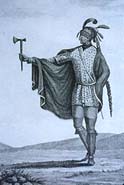
 |
| Indian of the Nation of the Kaskaskia. (engraving from a sketch by General George-Victor Collot, 1796) |
War chiefs organized raids against enemy tribes, usually beginning in the month of February. The war chief would invite about 20 warriors to a feast, where each man would pray to his own war manitou--a bird spirit represented by the skin of a falcon, crow, duck, parrot, or other bird--for such speed in running as to strike fear in the hearts of his enemies. After closing on the enemy, the chief would offer a prayer to the warriors' birds, which he carried with him in a medicine bag, and each man would attack voicing the cry of his bird.
Warfare on a larger scale was sometimes waged against tribes living great distances west and south of the Illinois, including the Pawnee, who lived in the central Great Plains, and the Quapaw, who lived on the lower Arkansas River. On these campaigns, the Illinois organized large war parties consisting of most of the men and many of the women living in a village. Capturing prisoners was more highly esteemed than killing enemies. Some prisoners were killed; others were adopted or became slaves.![]()
|
|
Copyright © 2000 Illinois State Museum